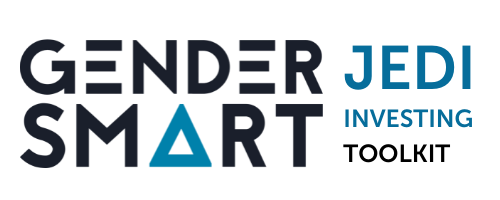
Get Started >
Develop a foundational understanding of core gender and JEDI investing tools and concepts.
Gender Lens Investing Foundations
Gender lens investing (GLI) is the process of integrating gender as a factor of analysis into investment processes for better social and financial outcomes, through six main lenses (see image).
These lenses are the kick-off point for embedding a deeper JEDI investing approach, which goes beyond gender equity to address power dynamics across gender, racial, and socioeconomic divides.
JEDI investments are not a distinct asset class but an approach that cuts across all asset classes. This can be integrated or intentional. Some investors make gender and JEDI principles part of their overall investment thesis (integrated). An intentional approach focuses on a specific strategic gender and JEDI lever, for example funding more diverse fund managers.
Six GLI lenses (click to enlarge)
JEDI Investing Across Asset Classes
How a JEDI lens gets applied also depends on where the investor sits in terms of mainstream or impact orientation. Generally speaking, a large proportion of mainstream investors are building a JEDI lens within their existing DEI frame, although this is changing in the US and Canada as people get more focused on racial equity and social justice investing.
Impact investors tend to prefer the broader buckets of social justice and equality investing, and strategies can span:
i) focusing on funding underrepresented and diverse funds/organisations
ii) funding diverse entrepreneurs, and/or
iii) investing specifically in critical consumer services that directly benefit under-represented population segments.
The asset class framework below illustrates how a JEDI lens can be applied across different asset classes, in both product and strategy. Specific fund examples will be added at a later date.
The framework has been adapted from Calvert Impact Capital’s asset class framework.
The Relevance of Systemic Barriers and Biases
Finance operates in a wider ecosystem of underlying social, economic and historical factors, all of which have an influence on who is making investment decisions, where knowledge resides, and how investments get structured and made. Understanding these factors will help investors deepen their gender and JEDI investing analysis, and make more impactful investments.
The structural and implicit biases described in the document below impact the selection of investment teams, fund managers, investment committees, and boards.
JEDI Investing principles
JEDI Investing Principles in Action Guides
In partnership with Triple C Advisory, we’ve created a series of guides for different actor types, across each JEDI Investing pathway. Get started below.
Asset Managers
Wealth Managers
Asset Owners
Family Offices and Foundations
Resources
Explore the library here.
Case Studies

What Next?
You may also find this Google sheet of JEDI investing communities, organisations and associations useful.













